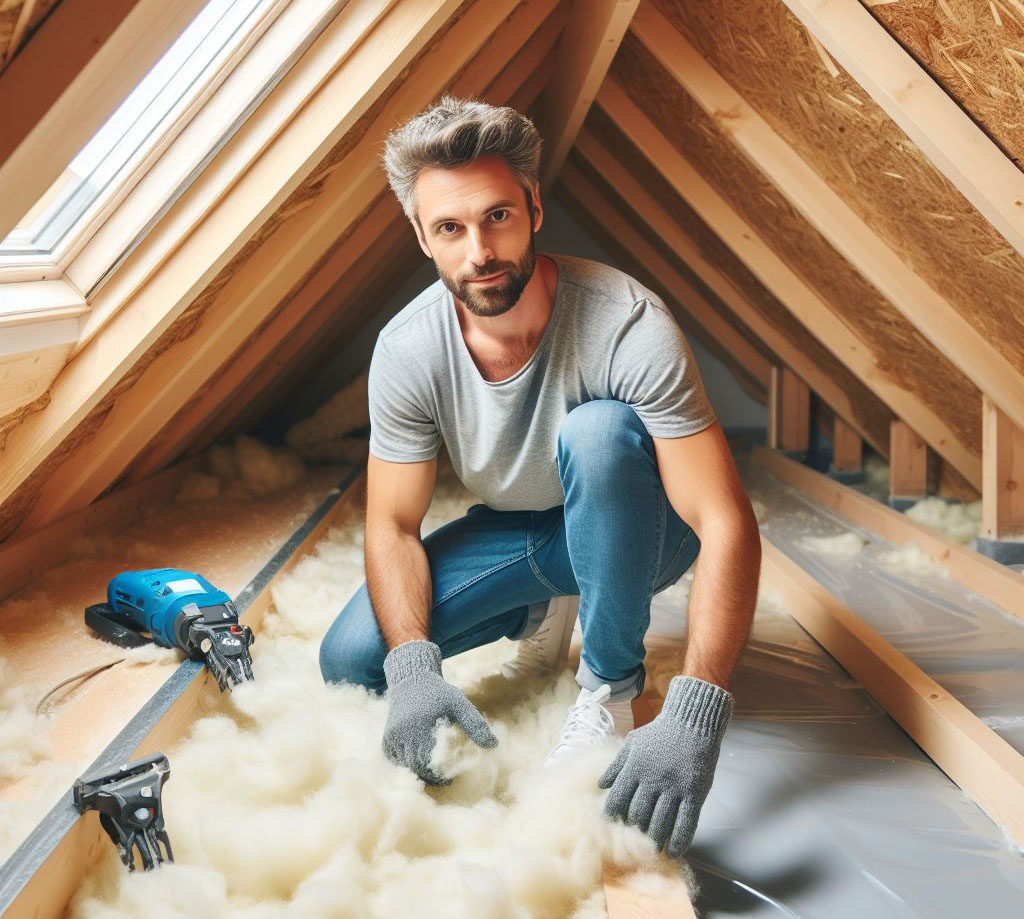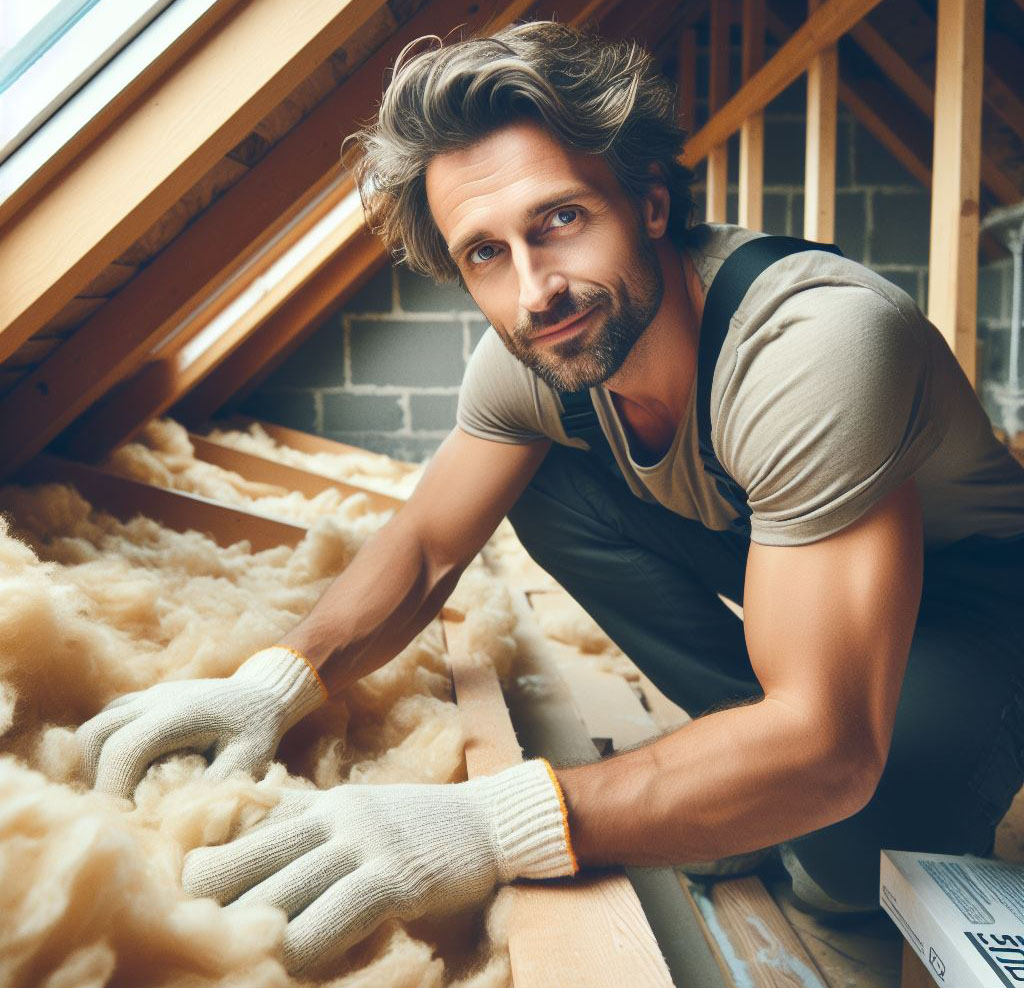In my extensive experience across the evolving landscape of home construction, I’ve encountered a multitude of attics, each with its unique character and challenges. The constant, however, remains the indisputable value of robust attic insulation. It’s the unsung hero, diligently working behind the scenes to maintain the sanctuary of your home. Properly installed, insulation in the attic serves as a steadfast barrier, adeptly managing the flow of heat, ensuring your space remains a haven of comfort regardless of the whims of the weather outside. This is not just about immediate comfort, it’s a strategic move that ensures energy efficiency and cost-effectiveness in the long run.
In this arena, fiberglass insulation emerges as a frontrunner. Its inherent properties of thermal resistance, coupled with commendable resistance to fire and moisture, make it a preferred choice for homeowners and professionals alike. It’s akin to having a steadfast guard, offering protection and peace of mind.

Preparing for Installation – Gear Up and Clear Out
The journey to a well-insulated attic begins with meticulous preparation and the right gear:
- Safety First:
- Don gloves to safeguard against the prickly nature of fiberglass. It’s crucial to maintain a respectful distance.
- A mask is your first line of defense against the minuscule, yet potentially bothersome, fiberglass particles. It ensures the air you breathe remains pristine.
- Protective goggles are imperative. They serve as vigilant guardians for your eyes, shielding them from the invisible fibrous assailants.
- Clearing the Space:
- The past often leaves relics behind, and old insulation is no exception. Its removal paves the way for the new, but caution is paramount. Historical insulation can harbor hidden hazards like asbestos or mold. In such instances, it’s prudent to enlist specialized professionals.
- A pristine space is the canvas upon which effective insulation is installed. Ensuring cleanliness and the absence of debris is not mere housekeeping, it’s a strategic step to optimize the performance of your new insulation.
- Tools and Materials:
- A utility knife, not just a tool but an extension of your hand, ensures precision cuts and a perfect fit for your insulation.
- The measuring tape, your silent partner, guarantees accuracy, ensuring every inch of space is accounted for.
- Fiberglass, in the form of batts or rolls, stands ready to be tailored to your space, offering a bespoke solution to your insulation needs.

Understanding Fiberglass Insulation – The What and the Why
Demystifying fiberglass insulation is key to harnessing its full potential:
- Types of Fiberglass Insulation:
- Batts are akin to ready-to-use blocks, conveniently sized for standard spaces and a testament to the practicality of pre-sized solutions.
- Rolls offer a versatile buffet of insulation, allowing you to tailor the size to the unique contours of your space, ensuring no nook is left unattended.
- R-Values Explained:
- R-value is the badge of honor of insulation, quantifying its thermal resistance prowess. However, the quest for the highest R-value is a nuanced journey. It’s about understanding the specific needs of your habitat and choosing the insulation that aligns with the climatic demands of your region. It’s a strategic choice, akin to selecting the appropriate gear for a particular expedition.
Installation Process
Embarking on the installation journey requires meticulous attention to detail and a methodical approach. Let’s dissect the process into manageable steps, ensuring clarity and precision at every turn.
Step 1: Measuring and Cutting
Accuracy in measuring is the foundation of effective insulation. Equip yourself with a reliable tape measure and record the dimensions of each segment destined for insulation. When cutting fiberglass, a flat surface and a sharp utility knife are indispensable. Employ a straightedge to guide your cuts, aiming for precision and neatness. Remember, accuracy in this step is not a luxury but a necessity, saving you both material and ensuring a snug fit.
Step 2: Fitting Fiberglass Insulation
With measured and cut insulation at hand, proceed to fit the batts or rolls into their designated spots. Start from one end, methodically working your way to the other, gently nestling the insulation between joists or studs. Exercise caution to avoid compression, the goal is a snug fit, not a forced one. Custom-fit your insulation around fixtures, maintaining the insulation’s integrity while accommodating the unique contours of pipes and electrical boxes. It’s a delicate balance, requiring patience and precision.
Step 3: Securing Insulation
While friction often suffices in holding the insulation in place, certain scenarios demand additional security. Insulation supports or wire mesh can serve as your secondary line of defense, ensuring the insulation remains undisturbed. Install these supports with care, ensuring they provide firm yet gentle reinforcement to your insulation.

Special Considerations
As we approach the final stages, a few critical considerations come to the forefront, pivotal in maximizing the efficacy of your insulation.
Insulating around Obstacles
Navigating obstacles such as wires, pipes, and vents requires a thoughtful approach. Custom-fit your insulation around these elements, ensuring continuity and integrity. It’s a task that demands precision and attention to detail, as the proper insulation of these areas is instrumental in preventing energy leaks and maintaining overall efficiency.
Avoiding Compression and Respecting Ventilation
A common pitfall in insulation is the inadvertent compression of materials. It’s imperative to understand that compression undermines the insulative properties, diminishing the effectiveness of your efforts. Additionally, maintaining proper ventilation, particularly near eaves, is paramount. These ventilation spaces are crucial in mitigating moisture buildup and maintaining an ecological balance within the attic. A well-ventilated space is integral to the longevity and performance of your insulation.
Post-Installation
The installation may be complete, but the journey to ensuring a well-insulated attic extends beyond the fitting of the last fiberglass batt. Attention to detail in the post-installation phase is what differentiates a satisfactory job from an exemplary one.
- Checking for Gaps and Ensuring Complete Coverage: Armed with a keen eye and a flashlight, embark on a thorough inspection of your newly insulated crawl space. Seek out any gaps or areas where the insulation isn’t perfectly flush. The smallest of gaps can undermine the overall effectiveness of your insulation, allowing precious heat to escape. If imperfections are found, address them promptly, ensuring a seamless and continuous blanket of insulation.
- Tips on Cleanup and Disposing of Old Insulation Material: The significance of a meticulous cleanup cannot be overstated. Proper disposal of any old insulation is crucial, particularly if it’s of a type that may contain hazardous materials. Consult local regulations and waste management services to ensure environmentally responsible and safe disposal. Remember, the presence of insulation fibers in the air can linger, so keep protective gear on until the area is thoroughly cleared.
Maintenance and Tips
The integrity of your attic insulation is not a static condition but a dynamic one that benefits greatly from regular monitoring and maintenance.
- Advice on Regular Checks for Pests, Mold, and Ensuring Insulation Remains Dry and In Place: Periodically inspecting your attic can reveal early signs of potential issues. Be vigilant for any indications of pests or mold, as they can compromise the effectiveness of your insulation. Equally important is the condition of the insulation itself – ensure it remains dry and properly positioned. Moisture or displacement can significantly diminish its insulative properties.
- Tips for Maximizing the Lifespan and Effectiveness of Your Insulation: The longevity and performance of your insulation are intrinsically linked to the environmental conditions within your attic. Proper ventilation plays a pivotal role in maintaining a balanced atmosphere, preventing the detrimental effects of moisture and temperature extremes. A well-ventilated attic is conducive to the sustained efficacy of your insulation.
FAQ Section
Selecting the appropriate R-value is a nuanced decision, influenced by your geographic location and the specific characteristics of your attic. Consulting the Department of Energy’s guidelines or seeking advice from a local insulation professional can provide clarity. The goal is to harmonize your insulation choice with the climatic conditions and unique attributes of your home.
Layering new insulation over old can be feasible, but it’s contingent on the condition of the existing material. If the old insulation exhibits signs of moisture, mold, or damage, it’s imperative to remove it. The foundation for your new insulation should be pristine to ensure optimal performance and avoid compounding problems.
Insulating these transitional areas requires a balance between maintaining thermal continuity and ensuring accessibility. Employing solutions like rigid foam board or specially designed insulative covers can effectively insulate these areas while preserving their functional integrity.
Tackling insulation installation during the temperate seasons, such as late spring or early fall, can offer a more comfortable working environment. Extreme temperatures can present challenges not only for the installer but also for the installation process itself.
While fiberglass insulation is renowned for its durability, periodic inspections every few years are advisable. Look for any signs of degradation, such as sagging, moisture presence, or pest infestation. Consistent performance and energy efficiency can be maintained through vigilant monitoring and timely intervention when necessary.
